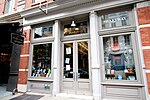Chambers Street (Manhattan)
Civic Center, ManhattanLower ManhattanNew York City road stubsStreets in ManhattanTribeca ... and 1 more
Use mdy dates from January 2021

Chambers Street is a two-way street in the New York City borough of Manhattan. It runs from River Terrace, Battery Park City in the west, past PS 234 (the Independence School), The Borough of Manhattan Community College, and Stuyvesant High School, to the Manhattan Municipal Building at 1 Centre Street in the east. Between Broadway and Centre Street, Chambers Street forms the northern boundary of the grounds surrounding New York City Hall and the Tweed Courthouse. Opposite the Tweed Courthouse sits the Surrogate's Courthouse for Manhattan. 280 Broadway the Marble Palace, lies west of there, on the north side of Chambers.
Excerpt from the Wikipedia article Chambers Street (Manhattan) (License: CC BY-SA 3.0, Authors, Images).Chambers Street (Manhattan)
Chambers Street, New York Manhattan
Geographical coordinates (GPS) Address Nearby Places Show on map
Geographical coordinates (GPS)
| Latitude | Longitude |
|---|---|
| N 40.715277777778 ° | E -74.008611111111 ° |
Address
Chambers Street 121
10013 New York, Manhattan
New York, United States
Open on Google Maps





